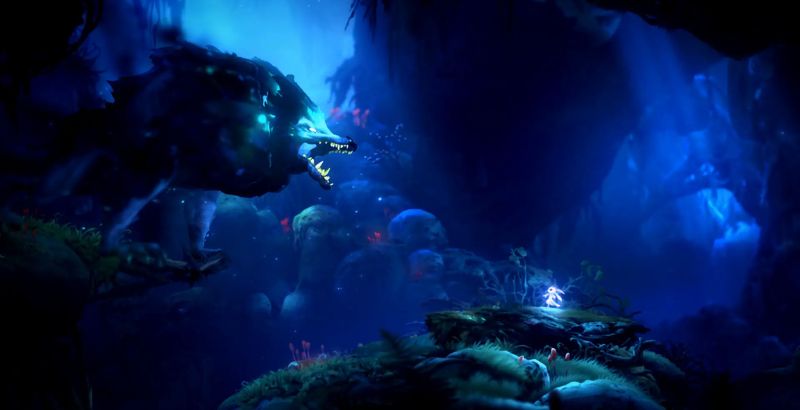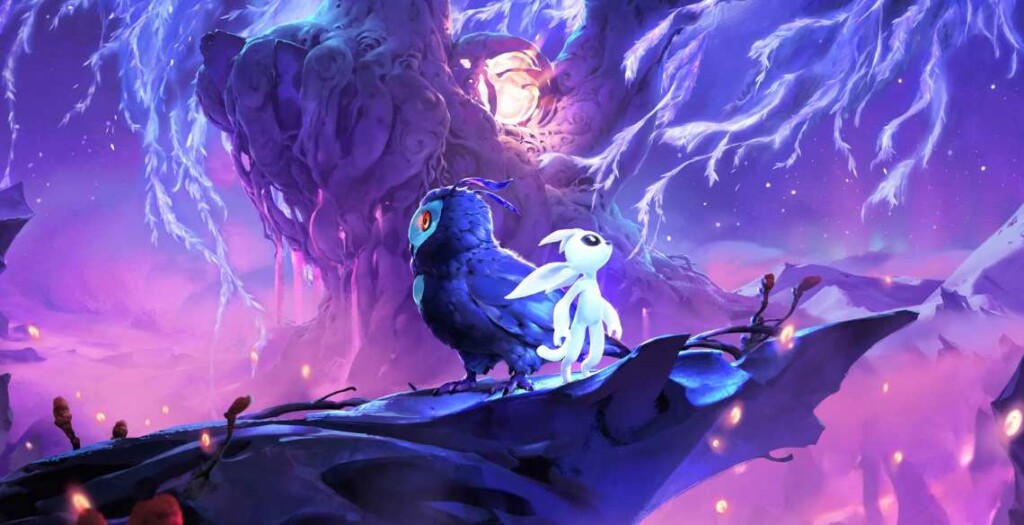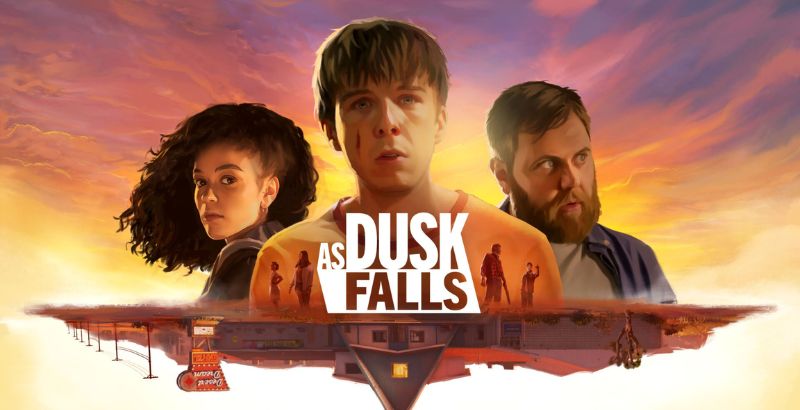Back in 2015, Moon Studios released Ori and the Blind Forest to critical acclaim and have now doubled down on everything that made that such a success with the sequel Ori and the Will of the Wisps. The studio took everything they learned from the previous installment and made a game that not only takes the Metroidvania genre and perfects what makes it so special and a mainstay for gamers for decades but also left us with one of the strongest titles on Xbox One to date as a bookend for this console generation and an early contender for Game of the Year.
Ori and the Will of the Wisps picks up right where the previous game left off, but not having that previous knowledge won’t diminish your experience in any way. Your adventure begins with Ori, a glowing fennec fox-like forest spirit. Ori and friends are raising a baby owl named Ku, who hatched in the aftermath of the previous game. If you played Ori and the Blind Forest, you’re already aware of the emotional gut-punch that that game opens with.
Ori Will of the Wisps opens with just as much emotional impact, as Ori is trying to teach Ku how to fly for the first time which ultimately leads to their separation and Ori’s quest to reunite with her. It’s a simple story, but one that is done masterfully with minimal dialog outside of text narrating key moments.
Imagine the opening moments of Pixar’s Up when there is no dialog and only the overwhelming powerful emotions that it was able to convey within those parameters in its short time. That is essentially the vibe Will of the Wisps maintains for most of its playtime and it is incredibly effective at making you care about these mostly voiceless characters.
Along with Ori’s adorable found family comes the sinister and terrifying Shriek, an owl who was born a little different from the others and was shunned for it. At first, you may be led to believe that she is just another dangerous beast that inhabits this dark forest. But you soon learn more about her background, and you’re quickly sympathetic towards her even when she is aggressively chasing you and you’re forced to make your escape. You understand her plight, and you’re immediately made to empathize with her.
The previous game did this to a similar effect with its main antagonist, Kuro. No matter which character, friendly or otherwise, I found myself being emotionally invested in their stories and in their safety, which is quite a feat, as all of the interactions are given to you with visuals and only some narration in particular moments. It’s a prime example of show-not-tell storytelling and the team at Moon Studios handled it perfectly and deserves all of the praise for it.
Ori and the Will of the Wisps is a gorgeous game with some of the best visuals

Right off the bat, Ori and the Will of the Wisps is a gorgeous game with some of the best visuals that can be found in any title available right now. The art design ranges from vibrant and colorful to dark and moody as each environment takes on its own feel and personality. The world may not be anything particularly new or groundbreaking — you’re going to see many areas that you’d expect in this type of game, like forests, deserts, and watery oases.
The art style makes each environment come to life, and there were a handful of times when I just took a moment to take in the beautiful visuals. Needless to say, I have a lot of new potential wallpapers after all of the screenshots I took throughout my playthrough.
One of the elements that received a lot of praise in Ori and the Blind Forest was Gareth Coker’s musical score. The music in Will of the Wisps is almost a character all of its own. In the same way that the environments and art design exist to convey a feel and an atmosphere, the orchestral tracks only exist to further that immersion. Each arrangement manages to evoke the feelings necessary in that moment.
They can vary from whimsical and hopeful to moody and dark to intense and fast-paced. They all fit in their respective spaces in the world perfectly and only make you more invested in what is taking place. As I’m writing this review, I’m currently listening to the soundtrack on Spotify. It’s just that good.
The Metroidvania genre has seen a big resurgence in recent years with amazing titles such as Hollow Knight, Axiom Verge, and the previous game in the Ori series. Will of the Wisps learns from its own predecessor and the other fantastic games in its genre and refines all of the mechanics. Backtracking and exploration are key components as you may expect and are facilitated by a fantastic and easy-to-understand map system. The map is fully upgradeable to eventually show off all of the collectibles, which there is an abundance of.
Returning from the first game are the various abilities that are also upgradeable as you progress through the game and defeat the various enemies. These abilities often double as attacks for combat and methods for traversing the environment. So in this game, and others of its type, you can expect to come across areas that are inaccessible until you acquire the necessary ability to progress. This usually means there is some more exploration that needs to be done, but this never feels like a chore since the environments are so fun and varied. There is also a fast travel system if you feel like speeding up the process a little.

Something new that is also very reminiscent of Hollow Knight is the inclusion of NPCs. In the first game, you were often alone and isolated. This time, different areas across the map are populated with different characters who offer you advice or side quests of their own. These quests are strewn throughout each area and often intersect with each other. It’s a very welcome addition and not only alleviates the feeling of isolation when traveling across this often scary and desolate forest but also makes the world feel more alive and lived-in.
The biggest difference from the previous game this time around is the combat. Ori and the Will of the Wisps expands the combat from Blind Forest significantly into something more similar in what we saw in Hollow Knight. Combat is more methodical, and there are now a host of new attacks, such as spears, swords, and exploding orbs that can be lobbed at enemies. In addition, there is a handful of collectibles called Shards that can be equipped to grant you extra passive skills like generating more money from enemy drops or allowing you to stick to walls. Each one has its benefits and makes for more than one way to play.
These customization options really allow you to feel like the Ori that you are playing as is your own personal Ori, tailored to your play style. Some Shards even make enemies strong if you want more of a challenge if you really want to sweat during the intense boss battles.
Challenge is also something that has become synonymous with its predecessor, and the sequel is no different in that regard. The platforming and the combat require precision if you’re to be successful, but I never had a situation where I felt frustrated or that the game was unfair. The save and checkpoint system is also much more lenient this time which does soften the blow of when you’re in a continuous death loop.
It can be trial and error at times, but I never got to a point where I was ready to rage quit after a prolonged beating from a particularly difficult boss or a demanding platforming segment. Also, the very difficult achievements for completing the game without dying and for beating the game in four hours or less make a return from the first game. If you’re a hardcore achievement hunter or just want to add to the already pretty intense difficulty, you’ll have plenty to sink your teeth into here.
Xbox has something special with Ori and the Will of the Wisps

Returning from the first game are also the chase sequences, offering some of the game’s biggest challenges. You’ll reach moments where you’ll be outrunning a flooded cavern or a large enemy careening towards you and you’ll have to rely on quick reflexes and a mastery of all of your traversal abilities if you’re to succeed. They can be daunting and the music is always intense as you avoid obstacles, but I was never in a situation where I felt like I was out of my league.
All of these perfectly crafted aspects aside, I did encounter a handful of areas where slow down was a recurring issue. The framerate would drop down pretty significantly and cause some troublesome lag. I also had one instance where the game crashed completely upon beating a difficult boss fight, and I was forced to start over. Slow down can cause a little bit of frustration, especially in instances where timing is required for combat or platforming.
It left me with a few headaches when these technical issues were the only thing keeping me from success. This is in no way a deal-breaker in any way and is something that could still be remedied, as it’s still very early in the game’s life cycle.
Ori and the Will of the Wisps is how you make a follow-up to an already fantastic game. Moon Studios took what they learned from Ori and the Blind Forest and expanded on and improved the formula in every way. Everything from combat, platforming, exploration, story, and world-building are fine-tuned to make an experience that shouldn’t be missed if you own an Xbox One or PC. The game may be challenging and intense at times, but is never unreasonable in its execution.
I haven’t been this emotionally invested in a game’s story and characters in quite some time, and I look forward to what I will learn from this one in the next installment. This is a game that definitely deserves to be a part of Game of the Year discussions going forward and will assuredly be somewhere on my personal list.
Ori and the Will of the Wisps is available for purchase on Xbox One and PC.
Ori and the Will of the Wisps
-
Rating - 9.5/109.5/10
TL;DR
Ori and the Will of the Wisps is how you make a follow-up to an already fantastic game. Moon Studios took what they learned from Ori and the Blind Forest and expanded on and improved the formula in every way. Everything from combat, platforming, exploration, story, and world-building are fine-tuned to make an experience that shouldn’t be missed if you own an Xbox One or PC.







